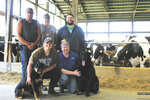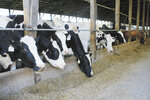

How did you get into farming? We are a fourth-generation dairy farm. It all started with our great-great-grandfather, Albe, and has been passed down from there. We have many family members involved and enjoy watching the passion the next generation has for the dairy grow.
What are the most significant ways your farm has changed since you started farming? One of the biggest and most recent changes that we have made was moving to a different facility that was 20 miles from the main operation. We made this move as we were outgrowing our facility and we could be more efficient with a larger parlor that was not 50 years old. We made this move about five years ago and have made some other changes too. Some of those would be switching to A.I. breeding on cows, improving herd genetics, working with a nutrient management plan as we are now a Concentrated Animal Feeding Operation-permitted farm, doubling cow numbers and focusing on better nutrition for our heifers.
What was a challenge you faced in your dairy farming career and how did you overcome it? One of the biggest challenges we faced was buying a facility that we didn’t construct ourselves. To this day, there are some valves or breakers that we are still unsure about as to what they control. It is difficult to move into a facility that was operating for 25 years and not know what kind of things were added on or where electrical lines or waterlines were dug. Then on the cow side, you have to adjust things because what worked at the other facility does not always work for this facility. One of the biggest challenges on the cow side in the new facility was switching to bedding with manure solids. We had to revamp our vaccination protocol and stall maintenance.
What is the best decision you have made on your farm? The best decision that we have made has been adjusting our heifer management protocols. When we doubled our number of milking cows five years ago, we also began increasing youngstock numbers. We have made many changes in movement, vaccinations, nutrition and handling of these heifers in the last five years. These changes are really showing up when we calve in these heifers. We have more consistency in all our first-lactation cows. Before, we would have a short, stubby heifer calve and a tall, angular heifer calve at the same time. This consistency gets those heifers off to a better start and helps improve the herd genetics. We are very excited to see what the future looks like for these upcoming heifers.
What are three things on the farm that you cannot live without? DairyComp would be our first one. We love being able to look at data that can help with so many different types of management decisions, whether that is which animals to cull, how the cows are starting off their lactations by looking at lactation curves, or being able to keep all our shot protocols in an orderly fashion.
FeedWatch would be another one. We just installed this in January and wish we would have done it earlier. It has been great for adjusting feed from day to day, adjusting dry matter and helping keep track of the feed inventory.
The third thing would be family. It really takes a team to keep everyone moving and operating efficiently. We have little cousins who work with us as well. We love watching their passion grow for dairy and that is what keeps us going.
What are your thoughts and concerns about the dairy industry for the next year? The biggest concerns are the volatile and low milk prices and the effects of inflation on everything else. Feed prices have been very high and then you add on fertilizer and chemical prices and it is very hard to make ends meet. We also have to always be looking at what we can do better to ensure the consumer is happy. We really enjoy educating the community about what we do and where their food comes from but we can always do more to keep educating people about agriculture.
What strategies do you use to withstand the volatile milk prices? We have been raising our own bull calves and finishing them out as steers. This helps cover the bills when the milk income cannot. We will sell them as calves as well if the price is right, so we do a lot of price checking to ensure we are making money in the end on the steers. We also raise all our own replacements and run them on pasture as we believe this helps keep down the input costs of raising them. We see huge health benefits with the heifers being on pasture. We do not see hoof and leg problems, the heifers stay fit and they seem to have a survival mode to them that helps them when they get commingled in the lactating herd.
How do you retain a good working relationship with your employee(s)? Or, how do you maintain family relationships while also working together? The biggest thing that we do here is to work right alongside our employees. This gives the employees a chance to help us with decisions, not just be told what to do. If they need time off, we are the ones working that shift and get to see first-hand if something is not working correctly or maybe a protocol needs to be tweaked. If there is a problem, we like to address it right when it happens. We have them explain every step and then the biggest thing is to have us explain to them WHY this is a problem. Just telling them they cannot do it will not teach them anything.
What do you find most rewarding about dairy farming? One thing that is really rewarding is seeing the next generation of cattle being born or freshening in. We have worked really hard with this in the last five years and enjoy seeing the future of our herd continue to improve. The other thing would be watching the next generation of our family grow in their passion for the dairy cow. We do a lot with the 4-H dairy project and the junior Holstein kids. Their willingness to learn and become successful in the dairy industry is what drives us to be the best we can be.
Tell us something special about your farm. Something unique about our dairy is that we bed with manure solids. We were thrown right into this when we moved to this facility, and we had to learn about it fast. It was a big learning curve, but we are happy that we stuck with it. The manure solids give us the ability to bed with as much bedding as is needed. We also are not being hard on equipment like sand can be. And the most beneficial thing we feel is that we are not adding any sand to the fields for crops. The product that is pumped out to the pits is a great nutrient for our cropland.
What are your plans for your dairy in the next year and five years? In the next year we would really like to start using the data we have on hand to the best of our ability. Right now, we feel that we are not using the data to its full capability. There is so much information we can gather in DairyComp and FeedWatch that we would like to use it more in some of our management practices. In the next five years, there is a lot that we hope to accomplish, including creating a succession plan for the next generation, doing an update in the parlor, improving ventilation in the freestall barn and keeping on with pushing to create consistency in the herd.
How do you or your family like to spend time when you are not doing chores? We enjoy a wide variety of activities, both related to the farm and recreational. We try to take the time to exhibit animals at the local, district, state and national shows. We are heavily involved in working with kids in our industry, in the 4-H dairy project and coaching junior Holstein members in dairy quiz bowl and dairy jeopardy contests. Jenna and Vanessa serve on our local Farm Bureau board of directors. Jenna also serves as president of our creamery’s district board. Paul serves as the creamery board’s vice president. Outside of the farm, we enjoy playing sand volleyball in the summer and fall.
Comments
No comments on this item Please log in to comment by clicking here